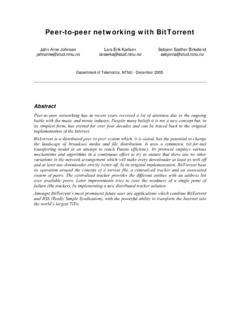Transcription of IPFS - Content Addressed, Versioned, P2P File System (DRAFT 3)
1 IPFS - Content Addressed, Versioned, P2P File System (DRAFT 3). Juan Benet ABSTRACT parties invested in the current model. But from another per- The InterPlanetary File System (IPFS) is a peer -to- peer dis- spective, new protocols have emerged and gained wide use tributed file System that seeks to connect all computing de- since the emergence of HTTP. What is lacking is upgrading vices with the same System of files. In some ways, IPFS design: enhancing the current HTTP web, and introducing is similar to the Web, but IPFS could be seen as a sin- new functionality without degrading user experience.
2 Gle BitTorrent swarm, exchanging objects within one Git Industry has gotten away with using HTTP this long be- repository. In other words, IPFS provides a high through- cause moving small files around is relatively cheap, even for put Content -addressed block storage model, with Content - small organizations with lots of traffic. But we are enter- addressed hyper links. This forms a generalized Merkle ing a new era of data distribution with new challenges: (a). DAG, a data structure upon which one can build versioned hosting and distributing petabyte datasets, (b) computing file systems, blockchains, and even a Permanent Web.
3 IPFS on large data across organizations, (c) high-volume high- combines a distributed hashtable, an incentivized block ex- definition on-demand or real-time media streams, (d) ver- change, and a self-certifying namespace. IPFS has no single sioning and linking of massive datasets, (e) preventing ac- point of failure, and nodes do not need to trust each other. cidental disappearance of important files, and more. Many of these can be boiled down to lots of data, accessible ev- erywhere. Pressed by critical features and bandwidth con- 1. INTRODUCTION cerns, we have already given up HTTP for different data There have been many attempts at constructing a global distribution protocols.
4 The next step is making them part distributed file System . Some systems have seen signifi- of the Web itself. cant success, and others failed completely. Among the aca- Orthogonal to efficient data distribution, version control demic attempts, AFS [6] has succeeded widely and is still systems have managed to develop important data collabo- in use today. Others [7, ?] have not attained the same ration workflows. Git, the distributed source code version success. Outside of academia, the most successful systems control System , developed many useful ways to model and have been peer -to- peer file-sharing applications primarily implement distributed data operations.
5 The Git toolchain geared toward large media (audio and video). Most no- offers versatile versioning functionality that large file distri- tably, Napster, KaZaA, and BitTorrent [2] deployed large bution systems severely lack. New solutions inspired by Git file distribution systems supporting over 100 million simul- are emerging, such as Camlistore [?], a personal file stor- taneous users. Even today, BitTorrent maintains a massive age System , and Dat [?] a data collaboration toolchain deployment where tens of millions of nodes churn daily [16]. and dataset package manager.
6 Git has already influenced These applications saw greater numbers of users and files dis- distributed filesystem design [9], as its Content addressed tributed than their academic file System counterparts. How- Merkle DAG data model enables powerful file distribution ever, the applications were not designed as infrastructure to strategies. What remains to be explored is how this data be built upon. While there have been successful repurpos- structure can influence the design of high-throughput ori- ings1 , no general file- System has emerged that offers global, ented file systems, and how it might upgrade the Web itself.
7 Low-latency, and decentralized distribution. This paper introduces IPFS, a novel peer -to- peer version- Perhaps this is because a good enough System for most controlled filesystem seeking to reconcile these issues. IPFS. use cases already exists: HTTP. By far, HTTP is the most synthesizes learnings from many past successful systems. successful distributed System of files ever deployed. Cou- Careful interface-focused integration yields a System greater pled with the browser, HTTP has had enormous technical than the sum of its parts. The central IPFS principle is and social impact.
8 It has become the de facto way to trans- modeling all data as part of the same Merkle DAG. mit files across the internet. Yet, it fails to take advantage of dozens of brilliant file distribution techniques invented in 2. BACKGROUND. the last fifteen years. From one prespective, evolving Web This section reviews important properties of successful infrastructure is near-impossible, given the number of back- peer -to- peer systems, which IPFS combines. wards compatibility constraints and the number of strong 1. For example, Linux distributions use BitTorrent to trans- Distributed Hash Tables mit disk images, and Blizzard, Inc.
9 Uses it to distribute Distributed Hash Tables (DHTs) are widely used to coor- video game Content . dinate and maintain metadata about peer -to- peer systems. For example, the BitTorrent MainlineDHT tracks sets of Block Exchanges - BitTorrent peers part of a torrent swarm. BitTorrent [3] is a widely successful peer -to- peer fileshar- ing System , which succeeds in coordinating networks of un- Kademlia DHT trusting peers (swarms) to cooperate in distributing pieces Kademlia [10] is a popular DHT that provides: of files to each other. Key features from BitTorrent and its 1.
10 Efficient lookup through massive networks: queries on ecosystem that inform IPFS design include: average contact dlog2 (n)e nodes. ( 20 hops for a 1. BitTorrent's data exchange protocol uses a quasi tit- network of 10, 000, 000 nodes). for-tat strategy that rewards nodes who contribute to each other, and punishes nodes who only leech others'. 2. Low coordination overhead: it optimizes the number resources. of control messages it sends to other nodes. 2. BitTorrent peers track the availability of file pieces, 3. Resistance to various attacks by preferring long-lived prioritizing sending rarest pieces first.










